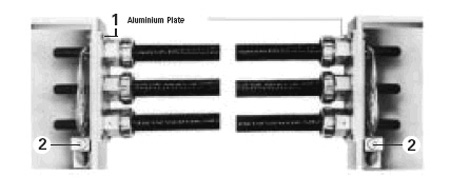
1. SINGLE- VS MULTI-CONDUCTOR CONSTRUCTIONS
It is generally accepted that armoured cable installations are more economical than pipe and wire installations, as wire pulling and conduit installation are not required. Armoured cables are readily available in single- and multi-conductor constructions. Various aspects should be considered when selecting either type. While single conductor cables might initially seem more economical, a summary analysis will reveal technical constraints such as voltage drop and installed costs that can substantially reduce any real cost advantages. Some of these technical concerns are outlined below.
COST OF MATERIAL
Cost analyses show multi-conductors to be more cost effective than single-conductors for many installations. Although single-conductors have higher ampacities, they require proportionally more insulation, armored and jacketing material than a comparable multi-conductor installation.
COST OF LABOUR
With single-conductors each phase must be installed separately, whereas all phases are installed at once when using multi-conductor cables.
VOLTAGE DROP
In multi-conductor cables, phase conductors (and neutral conductor, where present) are twisted together, for the minimum possible spacing. This geometry leads to the lowest inductive reactance and voltage drop. In single-conductor circuits, phase conductors are laid out in parallel. The extra thickness of the jacket and armour (where present), and the separation required to obtain more favourable free air ratings, lead to greater inductive reactance and voltage drop.
MAGNETIC FIELDS AND HARMONICS
Magnetic fields in harmonic frequencies of ascending order can cause unpredictable effects with sensitive electronic equipment such as computers and instrumentation. Expensive techniques such as shielding and filtering of power supplies often represent the only corrective solution. The mutual cancellation effect on magnetic fields of the fundamental (usually 60 hz) frequency is not necessarily extended to fields created by harmonic currents. The magnetic fields having frequencies of the third harmonic, or multiples of the third harmonic, reinforce rather than cancel, and this typically leads to higher magnetic field magnitude in the region surrounding single conductor cables.
This effect is greatly diminished in four-conductor constructions where the fields generated by the neutral conductors cancel the fields of the phase conductors. Harmonics are multiples of the original frequency (60 Hz) and can result from chopping of the waveforms of solid-state devices. Examples of such types of equipment include fluorescent lighting ballasts, dimmers, motor controls, and various other types of industrial control equipment. Odd harmonics (3rd, 5th, 7th, etc.) may cause damaging over-voltages spikes. Care should also be taken when selecting clamps and connectors. These should be made of non-ferrous materials to avoid overheating from magnetic hysteresis and eddy current losses produced by circulating magnetic fields. Given that third harmonics will amplify these effects, it is especially important to properly balance currents between parallel conductors of the same phase. Balancing third harmonic currents is almost impossible with single conductors. Special consideration should thus be given to multi-conductors, and especially to 4-conductor cable assemblies that can inherently balance harmonic currents.
2. INSTALLATION OF SINGLE-CONDUCTOR
AC90, ACWU90 AND TECK90 CABLES
In circuits rated 425 amps and larger, it is necessary to isolate the armour from the grounded metal of the enclosure and the armour of the other circuit conductors. Similarly, the armour must be adequately and continuously insulated from grounded metal such as tray or struts. The most satisfactory way to accomplish this is by means of an outer jacket over the armour. At the remote end of the cable, closest to the point of utilization, armour and bonding conductor will carry a significant potential difference to ground whenever current flows in the central conductor. A spark could be generated if the armour is grounded through accidental contact with grounded metal. The opening of a sheath circuit that has been accidentally grounded in this manner can produce a spark with considerable energy loss – an unexpected hazard for maintenance crews or non-electrical trades people working in the area. Single-conductor circuits in hazardous location are not recommended due to the risk of sparking initiated by standing voltages on the armour.
CIRCUITS RATED UP TO 425 AMPS INCLUSIVE
On any AC system, currents flowing in the centre conductor will induce small currents in the concentrically applied bonding wires and in the interlocked armour. For circuit ampacities up to and including 425 amps, these induced currents do not affect the cable ampacity and may be neglected. We recommend terminating the cables as follows: the bonding wires of all cables entering the equipment enclosure should be bunched and connected to the bonding screw of the terminal (2), the armour of each cable should be attached to the entry plate by means of an approved connector, and the entry plate should be aluminum or some other non-magnetic conducting material.
From: Wire and Cable and Wiring Methods Handbook, Vol 3, The Electricity Forum